2006 MERCEDES-BENZ SPRINTER sensor
[x] Cancel search: sensorPage 2109 of 2305
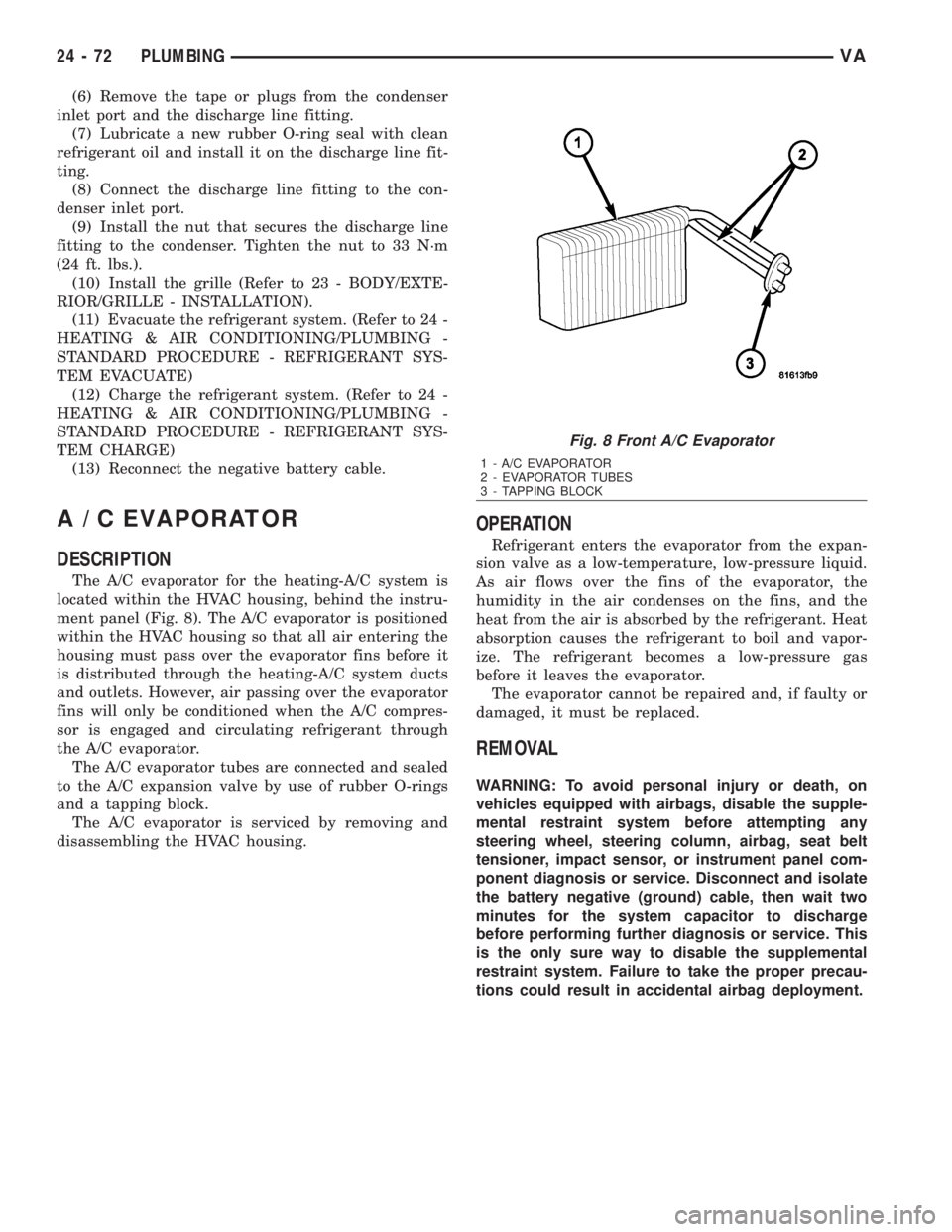
(6) Remove the tape or plugs from the condenser
inlet port and the discharge line fitting.
(7) Lubricate a new rubber O-ring seal with clean
refrigerant oil and install it on the discharge line fit-
ting.
(8) Connect the discharge line fitting to the con-
denser inlet port.
(9) Install the nut that secures the discharge line
fitting to the condenser. Tighten the nut to 33 N´m
(24 ft. lbs.).
(10) Install the grille (Refer to 23 - BODY/EXTE-
RIOR/GRILLE - INSTALLATION).
(11) Evacuate the refrigerant system. (Refer to 24 -
HEATING & AIR CONDITIONING/PLUMBING -
STANDARD PROCEDURE - REFRIGERANT SYS-
TEM EVACUATE)
(12) Charge the refrigerant system. (Refer to 24 -
HEATING & AIR CONDITIONING/PLUMBING -
STANDARD PROCEDURE - REFRIGERANT SYS-
TEM CHARGE)
(13) Reconnect the negative battery cable.
A/CEVAPORATOR
DESCRIPTION
The A/C evaporator for the heating-A/C system is
located within the HVAC housing, behind the instru-
ment panel (Fig. 8). The A/C evaporator is positioned
within the HVAC housing so that all air entering the
housing must pass over the evaporator fins before it
is distributed through the heating-A/C system ducts
and outlets. However, air passing over the evaporator
fins will only be conditioned when the A/C compres-
sor is engaged and circulating refrigerant through
the A/C evaporator.
The A/C evaporator tubes are connected and sealed
to the A/C expansion valve by use of rubber O-rings
and a tapping block.
The A/C evaporator is serviced by removing and
disassembling the HVAC housing.
OPERATION
Refrigerant enters the evaporator from the expan-
sion valve as a low-temperature, low-pressure liquid.
As air flows over the fins of the evaporator, the
humidity in the air condenses on the fins, and the
heat from the air is absorbed by the refrigerant. Heat
absorption causes the refrigerant to boil and vapor-
ize. The refrigerant becomes a low-pressure gas
before it leaves the evaporator.
The evaporator cannot be repaired and, if faulty or
damaged, it must be replaced.
REMOVAL
WARNING: To avoid personal injury or death, on
vehicles equipped with airbags, disable the supple-
mental restraint system before attempting any
steering wheel, steering column, airbag, seat belt
tensioner, impact sensor, or instrument panel com-
ponent diagnosis or service. Disconnect and isolate
the battery negative (ground) cable, then wait two
minutes for the system capacitor to discharge
before performing further diagnosis or service. This
is the only sure way to disable the supplemental
restraint system. Failure to take the proper precau-
tions could result in accidental airbag deployment.
Fig. 8 Front A/C Evaporator
1 - A/C EVAPORATOR
2 - EVAPORATOR TUBES
3 - TAPPING BLOCK
24 - 72 PLUMBINGVA
Page 2110 of 2305
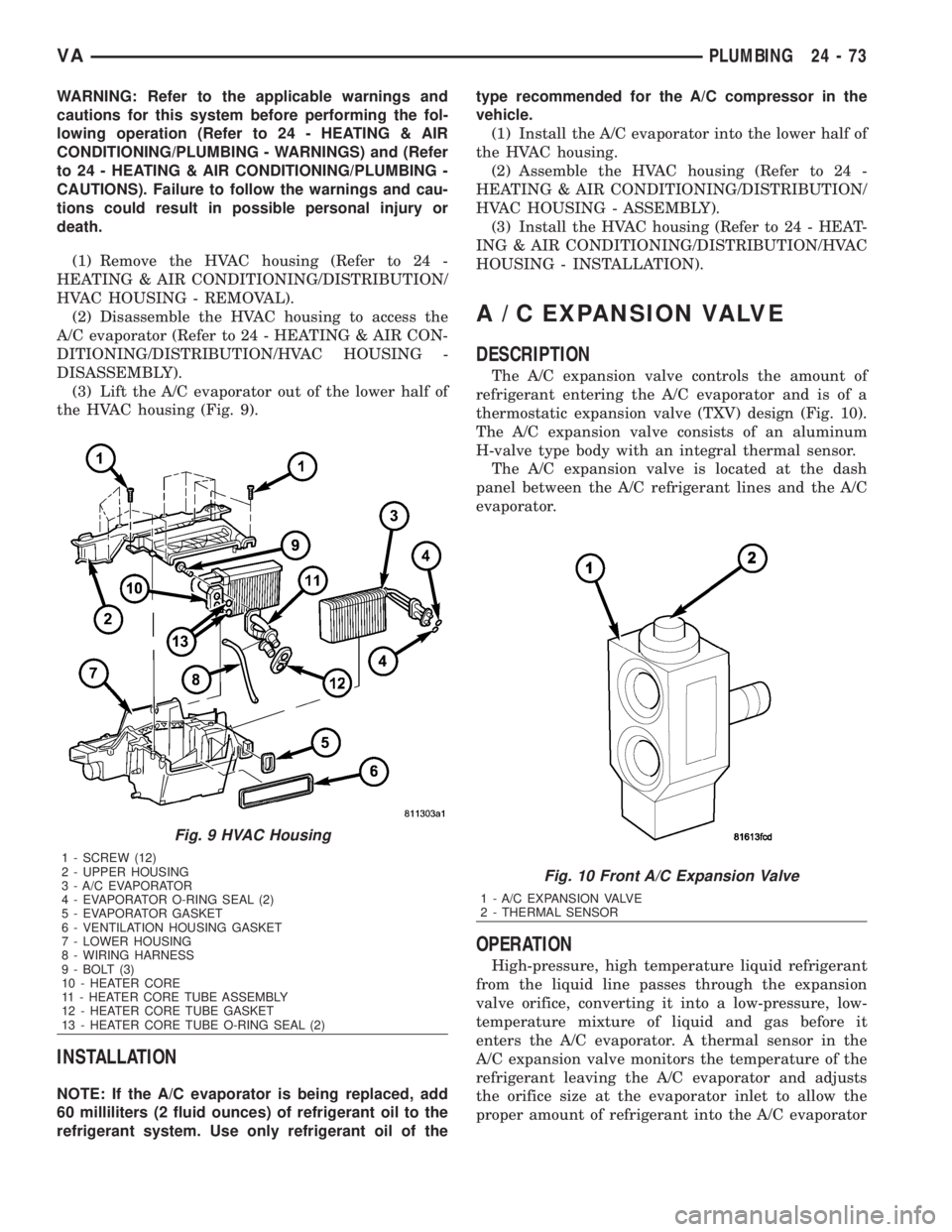
WARNING: Refer to the applicable warnings and
cautions for this system before performing the fol-
lowing operation (Refer to 24 - HEATING & AIR
CONDITIONING/PLUMBING - WARNINGS) and (Refer
to 24 - HEATING & AIR CONDITIONING/PLUMBING -
CAUTIONS). Failure to follow the warnings and cau-
tions could result in possible personal injury or
death.
(1) Remove the HVAC housing (Refer to 24 -
HEATING & AIR CONDITIONING/DISTRIBUTION/
HVAC HOUSING - REMOVAL).
(2) Disassemble the HVAC housing to access the
A/C evaporator (Refer to 24 - HEATING & AIR CON-
DITIONING/DISTRIBUTION/HVAC HOUSING -
DISASSEMBLY).
(3) Lift the A/C evaporator out of the lower half of
the HVAC housing (Fig. 9).
INSTALLATION
NOTE: If the A/C evaporator is being replaced, add
60 milliliters (2 fluid ounces) of refrigerant oil to the
refrigerant system. Use only refrigerant oil of thetype recommended for the A/C compressor in the
vehicle.
(1) Install the A/C evaporator into the lower half of
the HVAC housing.
(2) Assemble the HVAC housing (Refer to 24 -
HEATING & AIR CONDITIONING/DISTRIBUTION/
HVAC HOUSING - ASSEMBLY).
(3) Install the HVAC housing (Refer to 24 - HEAT-
ING & AIR CONDITIONING/DISTRIBUTION/HVAC
HOUSING - INSTALLATION).
A / C EXPANSION VALVE
DESCRIPTION
The A/C expansion valve controls the amount of
refrigerant entering the A/C evaporator and is of a
thermostatic expansion valve (TXV) design (Fig. 10).
The A/C expansion valve consists of an aluminum
H-valve type body with an integral thermal sensor.
The A/C expansion valve is located at the dash
panel between the A/C refrigerant lines and the A/C
evaporator.
OPERATION
High-pressure, high temperature liquid refrigerant
from the liquid line passes through the expansion
valve orifice, converting it into a low-pressure, low-
temperature mixture of liquid and gas before it
enters the A/C evaporator. A thermal sensor in the
A/C expansion valve monitors the temperature of the
refrigerant leaving the A/C evaporator and adjusts
the orifice size at the evaporator inlet to allow the
proper amount of refrigerant into the A/C evaporator
Fig. 9 HVAC Housing
1 - SCREW (12)
2 - UPPER HOUSING
3 - A/C EVAPORATOR
4 - EVAPORATOR O-RING SEAL (2)
5 - EVAPORATOR GASKET
6 - VENTILATION HOUSING GASKET
7 - LOWER HOUSING
8 - WIRING HARNESS
9 - BOLT (3)
10 - HEATER CORE
11 - HEATER CORE TUBE ASSEMBLY
12 - HEATER CORE TUBE GASKET
13 - HEATER CORE TUBE O-RING SEAL (2)
Fig. 10 Front A/C Expansion Valve
1 - A/C EXPANSION VALVE
2 - THERMAL SENSOR
VAPLUMBING 24 - 73
Page 2113 of 2305
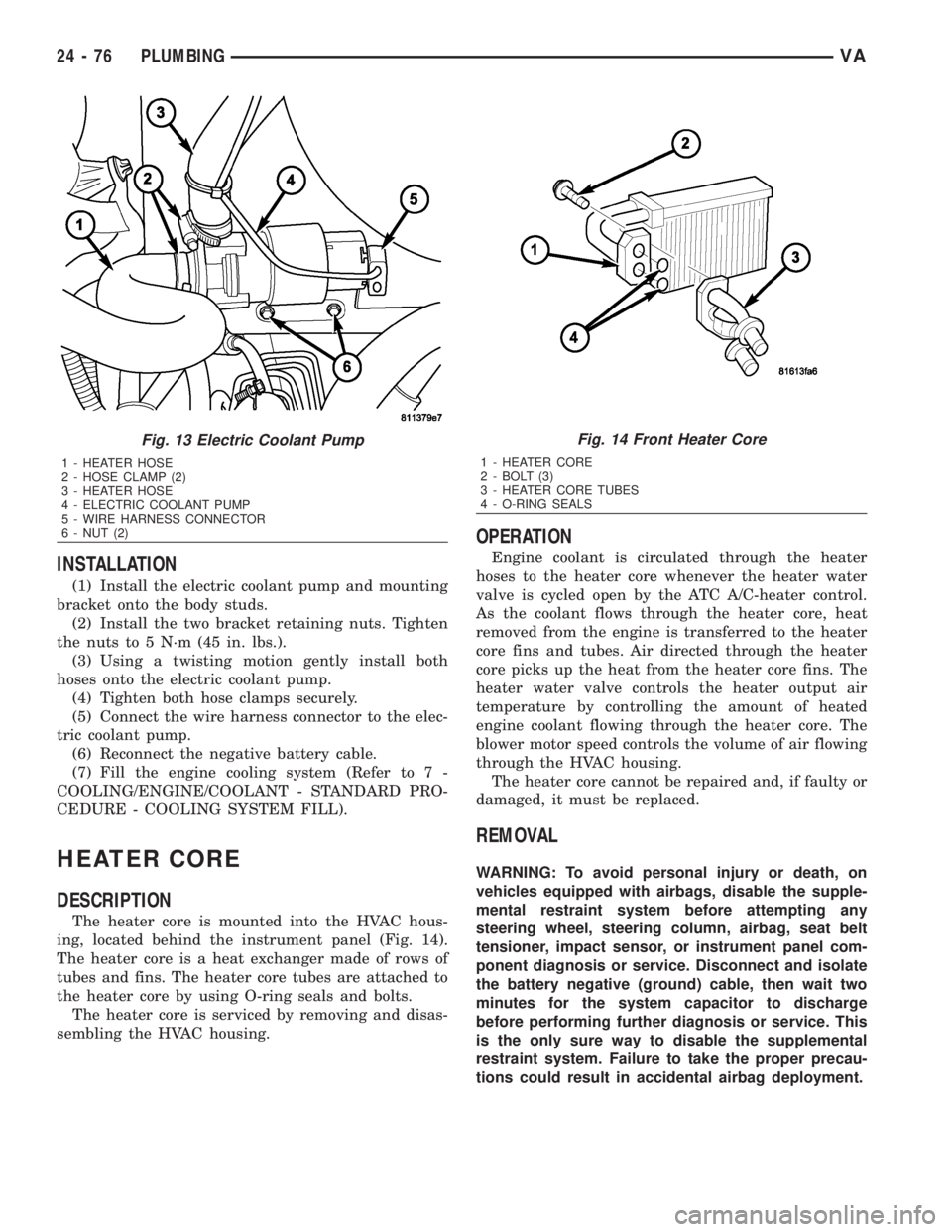
INSTALLATION
(1) Install the electric coolant pump and mounting
bracket onto the body studs.
(2) Install the two bracket retaining nuts. Tighten
the nuts to 5 N´m (45 in. lbs.).
(3) Using a twisting motion gently install both
hoses onto the electric coolant pump.
(4) Tighten both hose clamps securely.
(5) Connect the wire harness connector to the elec-
tric coolant pump.
(6) Reconnect the negative battery cable.
(7) Fill the engine cooling system (Refer to 7 -
COOLING/ENGINE/COOLANT - STANDARD PRO-
CEDURE - COOLING SYSTEM FILL).
HEATER CORE
DESCRIPTION
The heater core is mounted into the HVAC hous-
ing, located behind the instrument panel (Fig. 14).
The heater core is a heat exchanger made of rows of
tubes and fins. The heater core tubes are attached to
the heater core by using O-ring seals and bolts.
The heater core is serviced by removing and disas-
sembling the HVAC housing.
OPERATION
Engine coolant is circulated through the heater
hoses to the heater core whenever the heater water
valve is cycled open by the ATC A/C-heater control.
As the coolant flows through the heater core, heat
removed from the engine is transferred to the heater
core fins and tubes. Air directed through the heater
core picks up the heat from the heater core fins. The
heater water valve controls the heater output air
temperature by controlling the amount of heated
engine coolant flowing through the heater core. The
blower motor speed controls the volume of air flowing
through the HVAC housing.
The heater core cannot be repaired and, if faulty or
damaged, it must be replaced.
REMOVAL
WARNING: To avoid personal injury or death, on
vehicles equipped with airbags, disable the supple-
mental restraint system before attempting any
steering wheel, steering column, airbag, seat belt
tensioner, impact sensor, or instrument panel com-
ponent diagnosis or service. Disconnect and isolate
the battery negative (ground) cable, then wait two
minutes for the system capacitor to discharge
before performing further diagnosis or service. This
is the only sure way to disable the supplemental
restraint system. Failure to take the proper precau-
tions could result in accidental airbag deployment.
Fig. 13 Electric Coolant Pump
1 - HEATER HOSE
2 - HOSE CLAMP (2)
3 - HEATER HOSE
4 - ELECTRIC COOLANT PUMP
5 - WIRE HARNESS CONNECTOR
6 - NUT (2)
Fig. 14 Front Heater Core
1 - HEATER CORE
2 - BOLT (3)
3 - HEATER CORE TUBES
4 - O-RING SEALS
24 - 76 PLUMBINGVA
Page 2114 of 2305
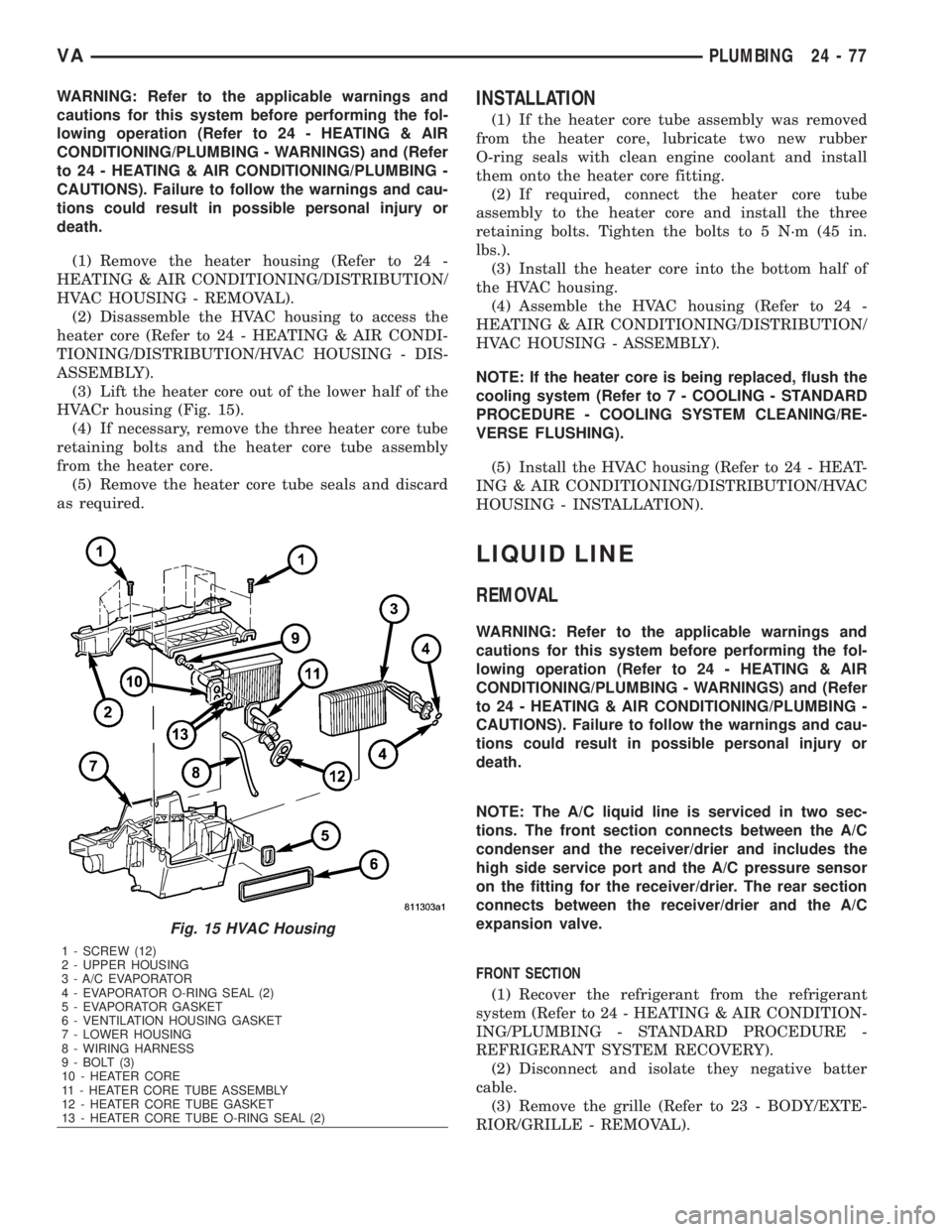
WARNING: Refer to the applicable warnings and
cautions for this system before performing the fol-
lowing operation (Refer to 24 - HEATING & AIR
CONDITIONING/PLUMBING - WARNINGS) and (Refer
to 24 - HEATING & AIR CONDITIONING/PLUMBING -
CAUTIONS). Failure to follow the warnings and cau-
tions could result in possible personal injury or
death.
(1) Remove the heater housing (Refer to 24 -
HEATING & AIR CONDITIONING/DISTRIBUTION/
HVAC HOUSING - REMOVAL).
(2) Disassemble the HVAC housing to access the
heater core (Refer to 24 - HEATING & AIR CONDI-
TIONING/DISTRIBUTION/HVAC HOUSING - DIS-
ASSEMBLY).
(3) Lift the heater core out of the lower half of the
HVACr housing (Fig. 15).
(4) If necessary, remove the three heater core tube
retaining bolts and the heater core tube assembly
from the heater core.
(5) Remove the heater core tube seals and discard
as required.INSTALLATION
(1) If the heater core tube assembly was removed
from the heater core, lubricate two new rubber
O-ring seals with clean engine coolant and install
them onto the heater core fitting.
(2) If required, connect the heater core tube
assembly to the heater core and install the three
retaining bolts. Tighten the bolts to 5 N´m (45 in.
lbs.).
(3) Install the heater core into the bottom half of
the HVAC housing.
(4) Assemble the HVAC housing (Refer to 24 -
HEATING & AIR CONDITIONING/DISTRIBUTION/
HVAC HOUSING - ASSEMBLY).
NOTE: If the heater core is being replaced, flush the
cooling system (Refer to 7 - COOLING - STANDARD
PROCEDURE - COOLING SYSTEM CLEANING/RE-
VERSE FLUSHING).
(5) Install the HVAC housing (Refer to 24 - HEAT-
ING & AIR CONDITIONING/DISTRIBUTION/HVAC
HOUSING - INSTALLATION).
LIQUID LINE
REMOVAL
WARNING: Refer to the applicable warnings and
cautions for this system before performing the fol-
lowing operation (Refer to 24 - HEATING & AIR
CONDITIONING/PLUMBING - WARNINGS) and (Refer
to 24 - HEATING & AIR CONDITIONING/PLUMBING -
CAUTIONS). Failure to follow the warnings and cau-
tions could result in possible personal injury or
death.
NOTE: The A/C liquid line is serviced in two sec-
tions. The front section connects between the A/C
condenser and the receiver/drier and includes the
high side service port and the A/C pressure sensor
on the fitting for the receiver/drier. The rear section
connects between the receiver/drier and the A/C
expansion valve.
FRONT SECTION
(1) Recover the refrigerant from the refrigerant
system (Refer to 24 - HEATING & AIR CONDITION-
ING/PLUMBING - STANDARD PROCEDURE -
REFRIGERANT SYSTEM RECOVERY).
(2) Disconnect and isolate they negative batter
cable.
(3) Remove the grille (Refer to 23 - BODY/EXTE-
RIOR/GRILLE - REMOVAL).
Fig. 15 HVAC Housing
1 - SCREW (12)
2 - UPPER HOUSING
3 - A/C EVAPORATOR
4 - EVAPORATOR O-RING SEAL (2)
5 - EVAPORATOR GASKET
6 - VENTILATION HOUSING GASKET
7 - LOWER HOUSING
8 - WIRING HARNESS
9 - BOLT (3)
10 - HEATER CORE
11 - HEATER CORE TUBE ASSEMBLY
12 - HEATER CORE TUBE GASKET
13 - HEATER CORE TUBE O-RING SEAL (2)
VAPLUMBING 24 - 77
Page 2115 of 2305
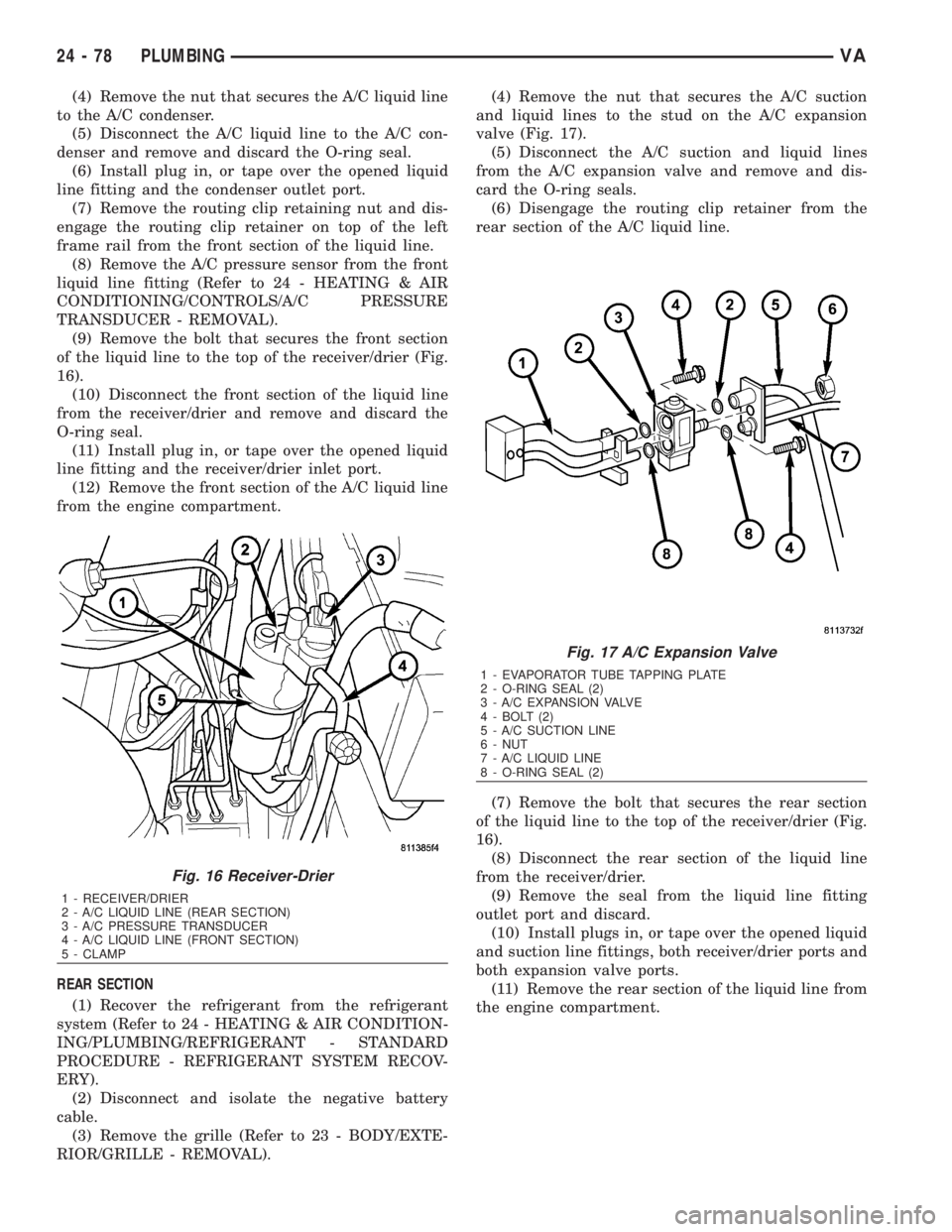
(4) Remove the nut that secures the A/C liquid line
to the A/C condenser.
(5) Disconnect the A/C liquid line to the A/C con-
denser and remove and discard the O-ring seal.
(6) Install plug in, or tape over the opened liquid
line fitting and the condenser outlet port.
(7) Remove the routing clip retaining nut and dis-
engage the routing clip retainer on top of the left
frame rail from the front section of the liquid line.
(8) Remove the A/C pressure sensor from the front
liquid line fitting (Refer to 24 - HEATING & AIR
CONDITIONING/CONTROLS/A/C PRESSURE
TRANSDUCER - REMOVAL).
(9) Remove the bolt that secures the front section
of the liquid line to the top of the receiver/drier (Fig.
16).
(10) Disconnect the front section of the liquid line
from the receiver/drier and remove and discard the
O-ring seal.
(11) Install plug in, or tape over the opened liquid
line fitting and the receiver/drier inlet port.
(12) Remove the front section of the A/C liquid line
from the engine compartment.
REAR SECTION
(1) Recover the refrigerant from the refrigerant
system (Refer to 24 - HEATING & AIR CONDITION-
ING/PLUMBING/REFRIGERANT - STANDARD
PROCEDURE - REFRIGERANT SYSTEM RECOV-
ERY).
(2) Disconnect and isolate the negative battery
cable.
(3) Remove the grille (Refer to 23 - BODY/EXTE-
RIOR/GRILLE - REMOVAL).(4) Remove the nut that secures the A/C suction
and liquid lines to the stud on the A/C expansion
valve (Fig. 17).
(5) Disconnect the A/C suction and liquid lines
from the A/C expansion valve and remove and dis-
card the O-ring seals.
(6) Disengage the routing clip retainer from the
rear section of the A/C liquid line.
(7) Remove the bolt that secures the rear section
of the liquid line to the top of the receiver/drier (Fig.
16).
(8) Disconnect the rear section of the liquid line
from the receiver/drier.
(9) Remove the seal from the liquid line fitting
outlet port and discard.
(10) Install plugs in, or tape over the opened liquid
and suction line fittings, both receiver/drier ports and
both expansion valve ports.
(11) Remove the rear section of the liquid line from
the engine compartment.
Fig. 16 Receiver-Drier
1 - RECEIVER/DRIER
2 - A/C LIQUID LINE (REAR SECTION)
3 - A/C PRESSURE TRANSDUCER
4 - A/C LIQUID LINE (FRONT SECTION)
5 - CLAMP
Fig. 17 A/C Expansion Valve
1 - EVAPORATOR TUBE TAPPING PLATE
2 - O-RING SEAL (2)
3 - A/C EXPANSION VALVE
4 - BOLT (2)
5 - A/C SUCTION LINE
6 - NUT
7 - A/C LIQUID LINE
8 - O-RING SEAL (2)
24 - 78 PLUMBINGVA
Page 2122 of 2305
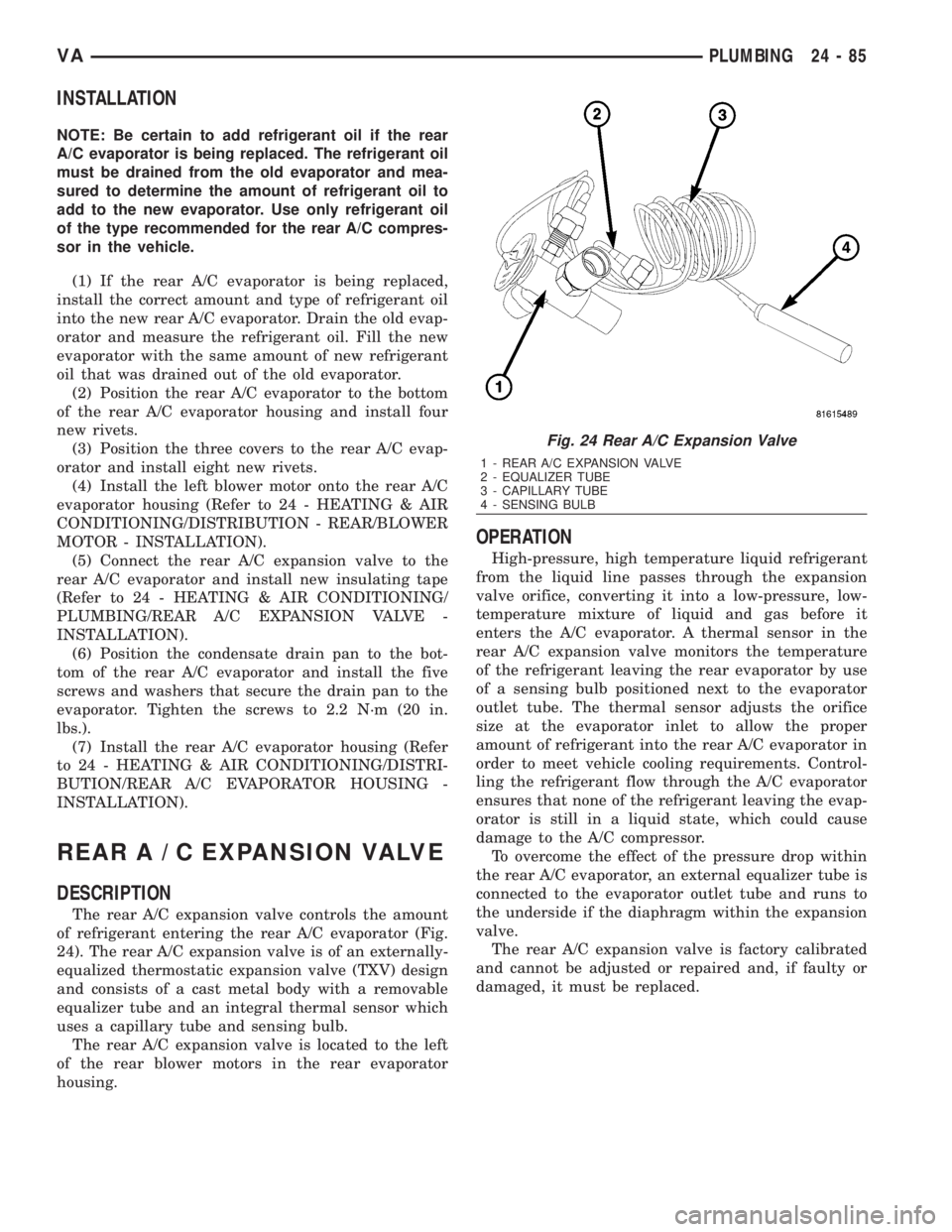
INSTALLATION
NOTE: Be certain to add refrigerant oil if the rear
A/C evaporator is being replaced. The refrigerant oil
must be drained from the old evaporator and mea-
sured to determine the amount of refrigerant oil to
add to the new evaporator. Use only refrigerant oil
of the type recommended for the rear A/C compres-
sor in the vehicle.
(1) If the rear A/C evaporator is being replaced,
install the correct amount and type of refrigerant oil
into the new rear A/C evaporator. Drain the old evap-
orator and measure the refrigerant oil. Fill the new
evaporator with the same amount of new refrigerant
oil that was drained out of the old evaporator.
(2) Position the rear A/C evaporator to the bottom
of the rear A/C evaporator housing and install four
new rivets.
(3) Position the three covers to the rear A/C evap-
orator and install eight new rivets.
(4) Install the left blower motor onto the rear A/C
evaporator housing (Refer to 24 - HEATING & AIR
CONDITIONING/DISTRIBUTION - REAR/BLOWER
MOTOR - INSTALLATION).
(5) Connect the rear A/C expansion valve to the
rear A/C evaporator and install new insulating tape
(Refer to 24 - HEATING & AIR CONDITIONING/
PLUMBING/REAR A/C EXPANSION VALVE -
INSTALLATION).
(6) Position the condensate drain pan to the bot-
tom of the rear A/C evaporator and install the five
screws and washers that secure the drain pan to the
evaporator. Tighten the screws to 2.2 N´m (20 in.
lbs.).
(7) Install the rear A/C evaporator housing (Refer
to 24 - HEATING & AIR CONDITIONING/DISTRI-
BUTION/REAR A/C EVAPORATOR HOUSING -
INSTALLATION).
REARA/CEXPANSION VALVE
DESCRIPTION
The rear A/C expansion valve controls the amount
of refrigerant entering the rear A/C evaporator (Fig.
24). The rear A/C expansion valve is of an externally-
equalized thermostatic expansion valve (TXV) design
and consists of a cast metal body with a removable
equalizer tube and an integral thermal sensor which
uses a capillary tube and sensing bulb.
The rear A/C expansion valve is located to the left
of the rear blower motors in the rear evaporator
housing.
OPERATION
High-pressure, high temperature liquid refrigerant
from the liquid line passes through the expansion
valve orifice, converting it into a low-pressure, low-
temperature mixture of liquid and gas before it
enters the A/C evaporator. A thermal sensor in the
rear A/C expansion valve monitors the temperature
of the refrigerant leaving the rear evaporator by use
of a sensing bulb positioned next to the evaporator
outlet tube. The thermal sensor adjusts the orifice
size at the evaporator inlet to allow the proper
amount of refrigerant into the rear A/C evaporator in
order to meet vehicle cooling requirements. Control-
ling the refrigerant flow through the A/C evaporator
ensures that none of the refrigerant leaving the evap-
orator is still in a liquid state, which could cause
damage to the A/C compressor.
To overcome the effect of the pressure drop within
the rear A/C evaporator, an external equalizer tube is
connected to the evaporator outlet tube and runs to
the underside if the diaphragm within the expansion
valve.
The rear A/C expansion valve is factory calibrated
and cannot be adjusted or repaired and, if faulty or
damaged, it must be replaced.
Fig. 24 Rear A/C Expansion Valve
1 - REAR A/C EXPANSION VALVE
2 - EQUALIZER TUBE
3 - CAPILLARY TUBE
4 - SENSING BULB
VAPLUMBING 24 - 85
Page 2123 of 2305
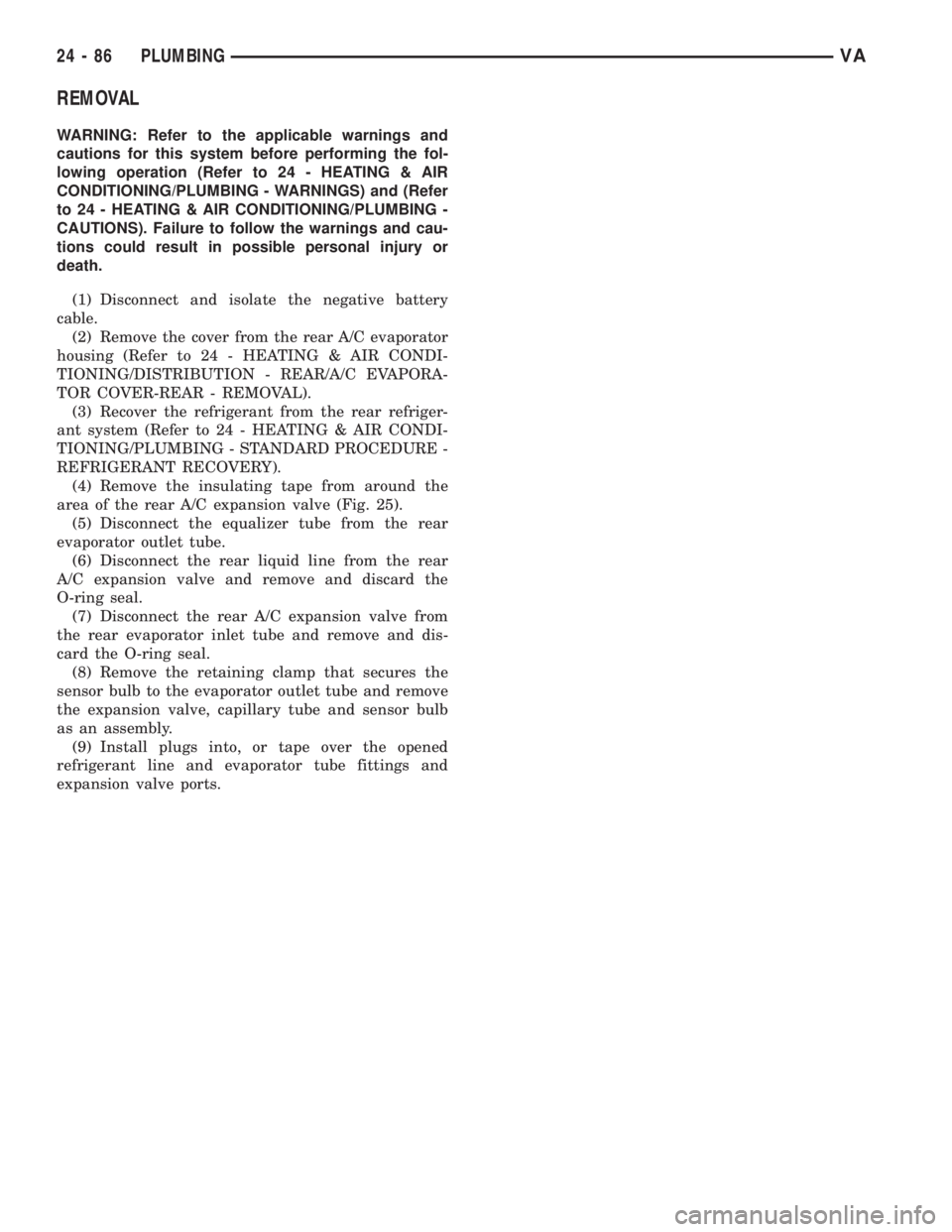
REMOVAL
WARNING: Refer to the applicable warnings and
cautions for this system before performing the fol-
lowing operation (Refer to 24 - HEATING & AIR
CONDITIONING/PLUMBING - WARNINGS) and (Refer
to 24 - HEATING & AIR CONDITIONING/PLUMBING -
CAUTIONS). Failure to follow the warnings and cau-
tions could result in possible personal injury or
death.
(1) Disconnect and isolate the negative battery
cable.
(2) Remove the cover from the rear A/C evaporator
housing (Refer to 24 - HEATING & AIR CONDI-
TIONING/DISTRIBUTION - REAR/A/C EVAPORA-
TOR COVER-REAR - REMOVAL).
(3) Recover the refrigerant from the rear refriger-
ant system (Refer to 24 - HEATING & AIR CONDI-
TIONING/PLUMBING - STANDARD PROCEDURE -
REFRIGERANT RECOVERY).
(4) Remove the insulating tape from around the
area of the rear A/C expansion valve (Fig. 25).
(5) Disconnect the equalizer tube from the rear
evaporator outlet tube.
(6) Disconnect the rear liquid line from the rear
A/C expansion valve and remove and discard the
O-ring seal.
(7) Disconnect the rear A/C expansion valve from
the rear evaporator inlet tube and remove and dis-
card the O-ring seal.
(8) Remove the retaining clamp that secures the
sensor bulb to the evaporator outlet tube and remove
the expansion valve, capillary tube and sensor bulb
as an assembly.
(9) Install plugs into, or tape over the opened
refrigerant line and evaporator tube fittings and
expansion valve ports.
24 - 86 PLUMBINGVA
Page 2151 of 2305
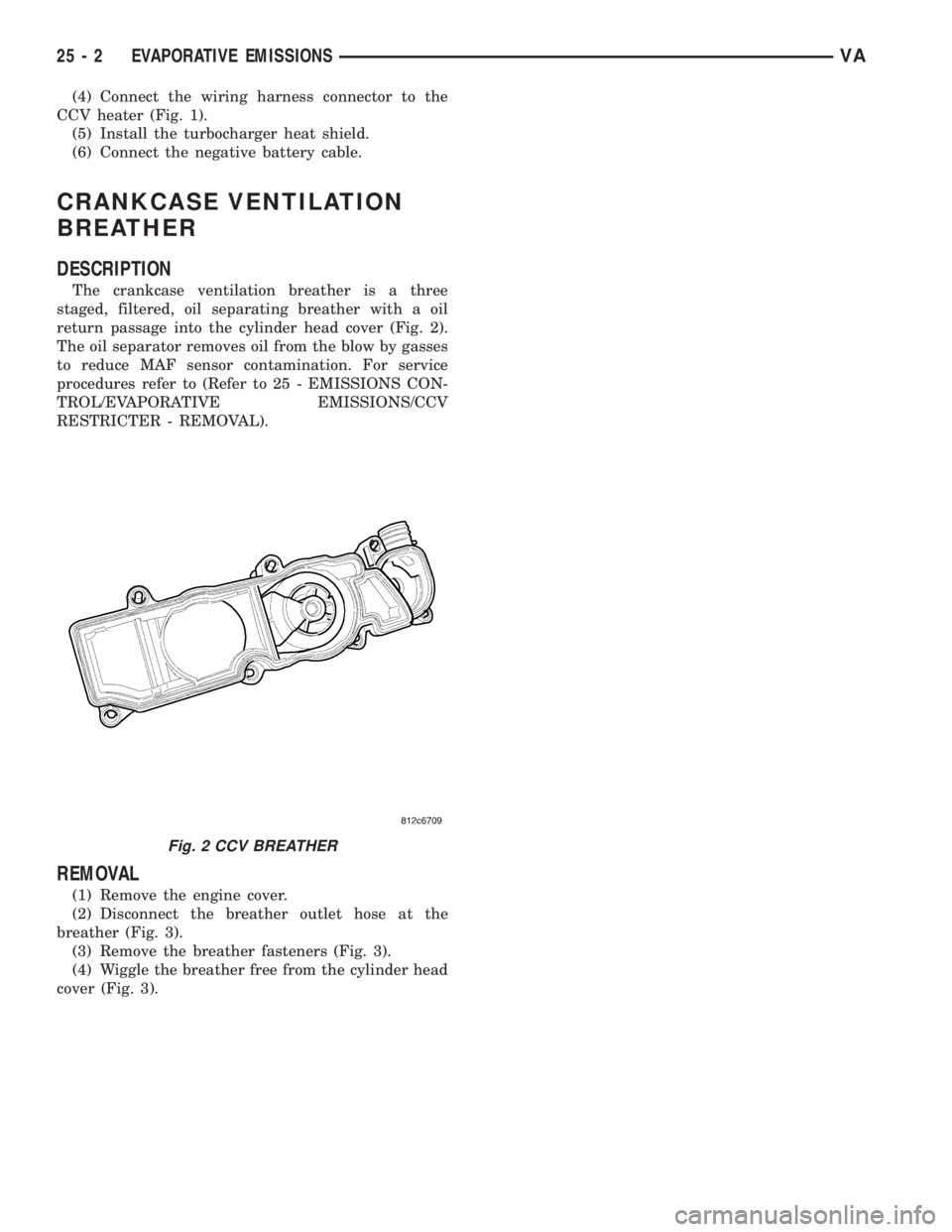
(4) Connect the wiring harness connector to the
CCV heater (Fig. 1).
(5) Install the turbocharger heat shield.
(6) Connect the negative battery cable.
CRANKCASE VENTILATION
BREATHER
DESCRIPTION
The crankcase ventilation breather is a three
staged, filtered, oil separating breather with a oil
return passage into the cylinder head cover (Fig. 2).
The oil separator removes oil from the blow by gasses
to reduce MAF sensor contamination. For service
procedures refer to (Refer to 25 - EMISSIONS CON-
TROL/EVAPORATIVE EMISSIONS/CCV
RESTRICTER - REMOVAL).
REMOVAL
(1) Remove the engine cover.
(2) Disconnect the breather outlet hose at the
breather (Fig. 3).
(3) Remove the breather fasteners (Fig. 3).
(4) Wiggle the breather free from the cylinder head
cover (Fig. 3).
Fig. 2 CCV BREATHER
25 - 2 EVAPORATIVE EMISSIONSVA